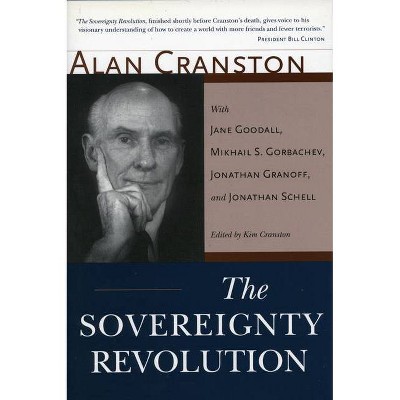The Attention Revolution - by B Alan Wallace (Paperback)

Similar Products
Products of same category from the store
AllProduct info
<p/><br></br><p><b> About the Book </b></p></br></br>Shamatha meditation is a method for achieving previously inconceivable levels of concentration. Author B. Alan Wallace, an active participant in the much-publicized dialogues between Buddhists and scholars, has more than 20 years' practice in the discipline, some of it under the guidance of the Dalai Lama. This book is a definitive presentation of his knowledge of shamatha. It is aimed at the contemporary seeker who is distracted and defocused by the dizzying pace of modern life, as well as those suffering from depression and other mental maladies. Beginning by addressing the inherent problems that follow from an inability to focus, Wallace moves on to explore varying levels of meditation. The result is an interior travelogue that recounts an exciting, rewarding "expedition of the mind," tracing everything from the confusions at the bottom of the trail to the extraordinary clarity and power that come with making it to the top.<p/><br></br><p><b> Book Synopsis </b></p></br></br>Meditation offers, in addition to its many other benefits, a method for achieving previously inconceivable levels of concentration. Author B. Alan Wallace has nearly thirty years' practice in attention-enhancing meditation, including a retreat he performed under the guidance of the Dalai Lama. An active participant in the much-publicized dialogues between Buddhists and scientists, Alan is uniquely qualified to speak intelligently to both camps, and <i>The Attention Revolution</i> is the definitive presentation of his knowledge. <p/>Beginning by pointing out the ill effects that follow from our inability to focus, Wallace moves on to explore a systematic path of meditation to deepen our capacity for deep concentration. The result is an exciting, rewarding expedition of the mind, tracing everything from the confusion at the bottom of the trail to the extraordinary clarity and power that come with making it to the top. Along the way, the author also provides interludes and complementary practices for cultivating love, compassion, and clarity in our waking and dreaming lives. <p/>Attention is the key that makes personal change possible, and the good news is that it can be trained. This book shows how.<p/><br></br><p><b> Review Quotes </b></p></br></br><br>A useful and stimulating resource for experienced meditators, while for those newer to meditation it gives an interesting and sometimes inspiring overview. The book is structured around each of Kamalashila's ten stages of meditation, with interludes outlining important supportive practices. There are also some instructions on how to achieve lucid dreaming as a basis for dream yoga-making the dream state a basis for insight. [...] The book contains much that could enrich the practice of anyone who already meditates regularly.-- "Wildmind Newsletter"<br><br>Alan Wallace--ex-monk, Tibetan translator and big-wig scientist--explores how we (don't) pay attention in <i>The Attention Revolution</i>. You put it down feeling that meditation isn't about some existential leap to another ethereal plane, but rather the gradual and incremental development of what is ours to begin with.-- "Elephant Journal"<br><br>Are you in a chronic state of distractedness? Maybe you think it is just part of modern life, yet there is an answer. It's called meditation. But this is not just another book on meditation. Attention is the key: identifying just what it is that requires attention, and how to focus on it. Analytical yet practical, Wallace's style conveys very clear instructions with calm authority.-- "Mandala"<br><br>The mind falls into two ruts, excitation and laxity, and both are hindrances to attentional development. [In <i>The Attention Revolutlion</i>, ] Wallace reveals the value of meditation techniques developed in India and Tibet and explains why he is convinced they can help us all improve the faculty of attention. With great elan and rigor, he explores the ten stages of attentional development from directed attention all the way to shamatha, the last stage which may require 10,000 hours of practice. Wallace also includes interludes on the meditative cultivation of loving-kindness, compassion, empathetic joy, equanimity, tonglen (giving and taking), lucid dreaming, and dream yoga. Along the way, he offers cogent observations on genuine happiness as a symptom of a healthy, balanced mind.-- "Spirituality & Practice"<br><br>This is a bold little book. Its subtitle is a boast and a lure, echoing the muscular self-help books that promise to make you better, stronger, faster. But <i>The Attention Revolution</i> is a cleverly disguised book about pure shamatha meditation, which Wallace defines here as 'a path of attentional development that culminates in an attention that can be sustained effortlessly for hours on end.' Wallace is a former monk and translator for the Dalai Lama, and now a scientist and religious studies scholar who's logged thousands of hours on the cushion. Currently he's drumming up support for The Shamatha Project, a one-year residential retreat for thirty people that will involve scientific evaluation of the subjects before, during, and after the retreat. One imagines that this book could be the participant manual. <i>The Attention Revolution</i> follows a rigorous ten-stage framework described by the eighth-century Indian Buddhist contemplative Kamalashila, but Wallace repeats often that you don't have to subscribe to any particular creed to experience the benefits of shamatha-you just have to do the work.-- "Shambhala Sun"<br><br>An indispensable guide, not only for anyone who attempts to meditate, but for all those who aspire to cultivate a more harmonious relation to the agent that determines the quality of every instant of our lives: our own mind.--Matthieu Ricard, co-author of The Monk and the Philosopher and of The Quantum and the Lotus<br><br>Attention is perhaps our most precious commodity. Alan Wallace provides a tutorial of a rigorous form of attention training, shamatha meditation, described in Buddhist texts and practices. Wallace notes that current interpretations of meditation practices such as mindfulness may not reflect the [Buddha's] original intent. In the current rush to apply many Eastern traditions to our Western culture, some very important elements of the original teachings and practices run the risk of being lost. This careful study of shamatha is likely to lessen such losses.--Susan L. Smalley, Ph.D., Professor, UCLA School of Medicine<br><br>Indispensable for anyone wanting to understand the mind. A superb, clear set of exercises that will benefit everyone.--Paul Ekman, Professor Emeritus at University of California San Francisco, and author of Telling Lies and Emotions Revealed<br><br>Scholar, scientist, and adept practitioner Alan Wallace teaches the faculty of attention in a clear, concise, and profound manner. This book is a brilliant comprehensive analysis on the stages of the development of attentional balance and will be a classic in the field.--Joan Halifax, abbot of Upaya Zen Center and author of The Fruitful Darkness<br><br>This is the best kind of practical manual: a balance of clear instruction, theoretical background, and personal sharing. Alan Wallace never talks down to you; his calm authority, borne of years of practice under the best of teachers, shines through. I recommend this book to those of any spiritual tradition--or none--who wish to grow as human beings.--The Reverend Anthony Freeman, Editor of the Journal of Consciousness Studies<br><p/><br></br><p><b> About the Author </b></p></br></br>B. Alan Wallace is president of the Santa Barbara Institute for Consciousness Studies. He trained for many years as a monk in Buddhist monasteries in India and Switzerland. He has taught Buddhist theory and practice in Europe and America since 1976 and has served as interpreter for numerous Tibetan scholars and contemplatives, including H. H. the Dalai Lama. After graduating <i>summa cum laude</i> from Amherst College, where he studied physics and the philosophy of science, he earned his MA and PhD in religious studies at Stanford University. He has edited, translated, authored, and contributed to more than thirty books on Tibetan Buddhism, medicine, language, and culture, and the interface between science and religion. <p/>Daniel Goleman is the author of the international bestsellers <i>Emotional Intelligence</i>, <i>Working with Emotional Intelligence</i>, and <i>Social Intelligence</i>, and the co-author of the acclaimed business bestseller <i>Primal Leadership</i>. He was a science reporter for the <i>New York Times</i>, was twice nominated for the Pulitzer Prize, and received the American Psychological Association's Lifetime Achievement Award for his media writing. He lives in the Berkshires.
Price History
Price Archive shows prices from various stores, lets you see history and find the cheapest. There is no actual sale on the website. For all support, inquiry and suggestion messagescommunication@pricearchive.us




















